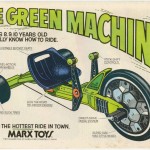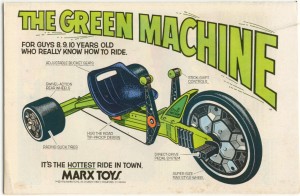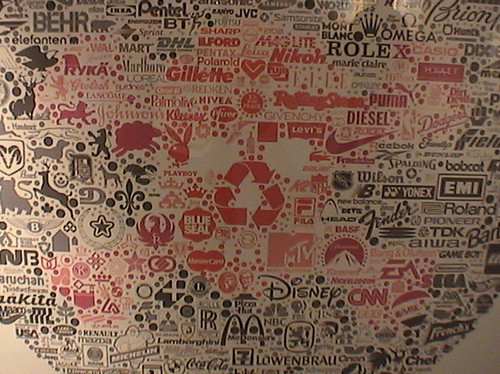 This article is part of the series — The Future of Your Brand Is … which will be unfolding here over the coming weeks. Check out The Futue of Your Brand is Play — Part 1 here.
This article is part of the series — The Future of Your Brand Is … which will be unfolding here over the coming weeks. Check out The Futue of Your Brand is Play — Part 1 here.
When I think back on my childhood friends and how those friendships started, I am amazed. I try to think what it was that drew me towards a particular child. I wonder what he or she saw in me. How did I negotiate the subtle rituals of friendship and why does “finding” new friends become more difficult as you grow older?
One of my nephews is master “friender” and I have been fascinated by his approach for years. I watch as he approaches groups of unknown kids. I observe his body language … when he hesitates, when he moves forward. I listen to his tone of voice. And I watch the other kids too. I love the naivety and openness of the way he interacts. It is both completely self conscious and unknowing. It is a complex performance which I should, by rights, pay to see.
But the thing that makes this work is that the kids are playing with the same building blocks. At this stage of life, the world is relatively small. Our personal knowledge bases are just being established. We are still learning. Filtering. Growing.
And while the ease with which most kids operate are bound up in the complex rules of our societies and cultures, they are also subject to the developmental themes that permeate our young lives. Understanding these themes explains at least a little, how we make friends and provides vital clues for brands seeking to reach new markets. We only need to test against a certain number of criteria before we discover an affinity … and from that affinity we can build a more grounded relationship — one experience at a time.
Branding and kid’s play
In the first part of The Future of Your Brand is Play, I talked about why some kids advertising works really well — because it taps into the nature and methods of kid’s play (and I used the Green Machine as an example). There are four major elements to this:
P — for power
L — for learning and curiosity
A — for adventure
Y — the yelp of surprise and delight
By structuring your messaging and experience design around these elements you are actually working with the major developmental themes of childhood. For example, when kids introduce themselves to each other, one of the last things they do is say their name. It is peripheral to the task at hand. The first step is to establish affinity — to walk through the building blocks of personal development, giving and taking, finding connections and moving to the next. If there are enough connections across these developmental themes, then the kids will become friends — at least for a period of time — and they become friends because they have created a context within which “friending” can occur. From that point, it is all about shared experience, social currency and, to be honest, shared infatuations.
But for brands to manifest these elements correctly, it needs to go deeper. There are four elements but a number of themes … and the more themes you touch upon, the faster and more completely will your strategy work. The themes and corresponding elements are as follows (let me know if you can see more):
P — for Power
- Demanding of attention
- Testing limits (boundaries around behaviour, responsibility etc)
- Controlling the controllable
- Belonging
L — for learning and curiosity
- Skills development
- Negotiation
A — for adventure
- Exploring an ever changing world
- Actively making the world a better place
Y — the yelp of surprise and delight
- Recognition and reward
- Self expression
 Green with Envy? No it’s a Green Machine!
Green with Envy? No it’s a Green Machine!
Using the Green Machine example, let’s take a look at how and why these elements and themes work.
P — for power
The name of the “Green Machine” provides a link to power. It organises the product around the sense of power that comes from automation. Clearly the child who rides a Green Machine is a tester of boundaries.
The design of the product is also aggressive — and innovative. While bikes have a standard set of handle bars, the Green Machine forgoes these, using hand levers instead. This means you will stand out from the crowd — attention (and plenty of it) will be yours.
L — for learning and curiosity
As infants start to gain a sense of their bodies, a wonderful transformation comes over the faces. They hold their hands up near their faces and watch as they control the small movements of their fingers. Not only is this a moment of mastery, but also a powerful stimulant to learn.
The design of the Green Machine is clearly radical. It immediately raises a lot of questions. What is it like to ride? How does the steering work? Will my friends think I am cool with this? There are questions of aspiration but also questions to do with the EXPERIENCE of the Green Machine. Just like the infant who suddenly becomes aware of her fingers, tapping into the experiential nature of this toy is a powerful attractant for kids.
A — for adventure
One of the things that I like about the Green Machine is that it is a DISRUPTIVE experience for kids. It turns the idea of a bike on its head. It moves away from “function” and focuses on designing a powerful experience for kids. In many ways the Green Machine is a non-linear innovation in the trajectory of bikes, and while it may not represent a permanent break — it exposes kids to the IDEA of an alternative.
And, of course, there are the standard elements of adventure in the product as well — a sense of challenge and “otherness”, the opportunity for mastery and control and the alignment of our sense of self with a brand/product that exists on the margin.
Y — the yelp of surprise and delight
Crossing over with Adventure, the sense of self expression that comes from the Green Machine is powerful. It is quite visceral. In my mind, I can hear the sound of the plastic wheels crunching across the concrete. I can feel the skidding. But most of all, I can hear my yell as it all happens. Clearly, this is going to be a fun toy. A fad perhaps. But a lot of fun.
Developing infatuations
One of the things that the Green Machine also does successfully is to provide its owner with instant social credibility. But this also extends to friends and acquaintances. There is an abundance of social currency in even standing next to it. The lure of social currency introduces us to the idea infatuation. Is it really the product or the brand that we want? Or is it what comes with it — the experience, the kudos, the shiny sheen of adulation (real or perceived)?
This public infatuation provides kids with a topic around which they can communicate that extends beyond their common developmental bonds. Through the experience of playing, using and sharing the Green Machine, kids are able to enter into a language that describes their shared world while also reinforcing it. Even the child whose infatuation is unrequited (ie who does not have access to the toy) can share in this experience. The product designers and copywriters have done their job well — providing kids with a language for infatuation — from the “adjustable bucket seats” through to the “hug the road tip-proof design” (and let’s face it, how many kids really will ride this on a road?). But by activating the PLAY elements and series of developmental themes, there is something greater to be learned … this is not just about kids, kids marketing or even play. It is about centering your brand around the experience of its greatest proponents. What we now call “word of mouth” was practiced daily in the schoolyards of my youth. Understanding that play is ageless opens yet another door to the future of your brand.
Play is ageless — content in the age of digital strategy
The Internet, social media, Web 2.0, game consoles and so on have brought a level of play into the world of adults and into the world of business. As Jordan McCollum points out, a study by Burst Media demonstrates that a range of age groups consider that Internet content is focused on their age group:
- 76% of 18-24 year olds believe this
- 73.9% of 25-34 year olds believe this
- 55.7% of 35-44 year olds believe this
And while the figures are massive from a targeting and positioning point of view something doesn’t add up. Well, it doesn’t add up in the world of old media and stale demographics. What this does suggest is that those who engage with and consume digital media do not conform to the patterns of behaviour that we have come to expect. This also means that if there is a belief that Internet content is focused around a wider number of people, then the potential reach of your branding efforts is mind bogglingly large. But how does a brand reach out to and engage with this wide, savvy and individualistic audience? This is about creating a bi-directional brand model. It is about tapping into the elements of PLAY and building your strategy around this. It is about KIDSPERIENCE.
My next excursion will take you into the world of “kidsperience”.
 Being a lover of good storytelling I live a life of disappointment between the hours of 8pm to midnight. With a vast array of low-rent, poorly executed television, there is little wonder that I turn my attention to the plethora of quality (and low-rent) content available online. And while I am sometimes appalled by what I see online, I have the control to simply move quickly to something that at least offers the promise of an engaging storyline, believable characters or even a toe-tapping number or two.
Being a lover of good storytelling I live a life of disappointment between the hours of 8pm to midnight. With a vast array of low-rent, poorly executed television, there is little wonder that I turn my attention to the plethora of quality (and low-rent) content available online. And while I am sometimes appalled by what I see online, I have the control to simply move quickly to something that at least offers the promise of an engaging storyline, believable characters or even a toe-tapping number or two.





